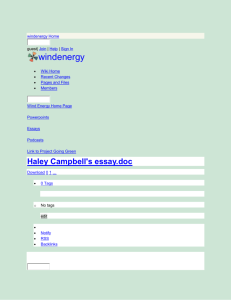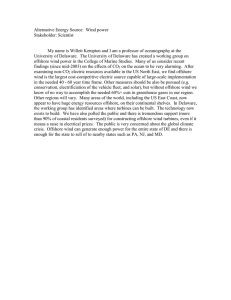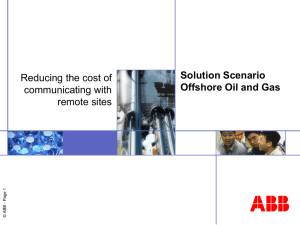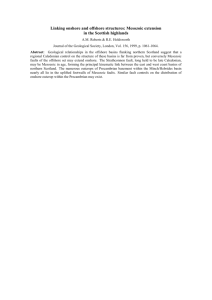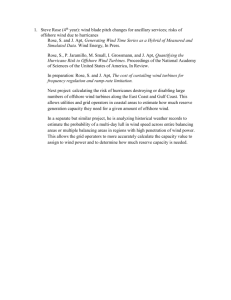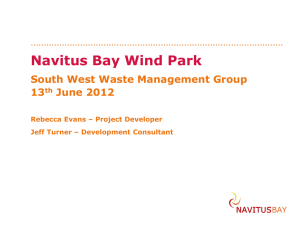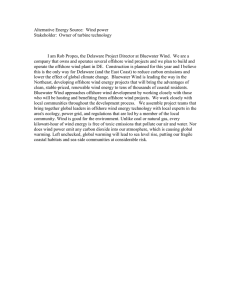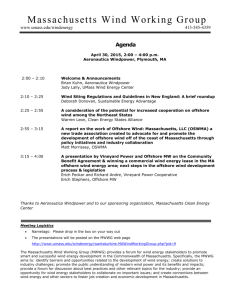WindEnergy Study 2004 Assessment of the Wind Energy Market until 2012
advertisement
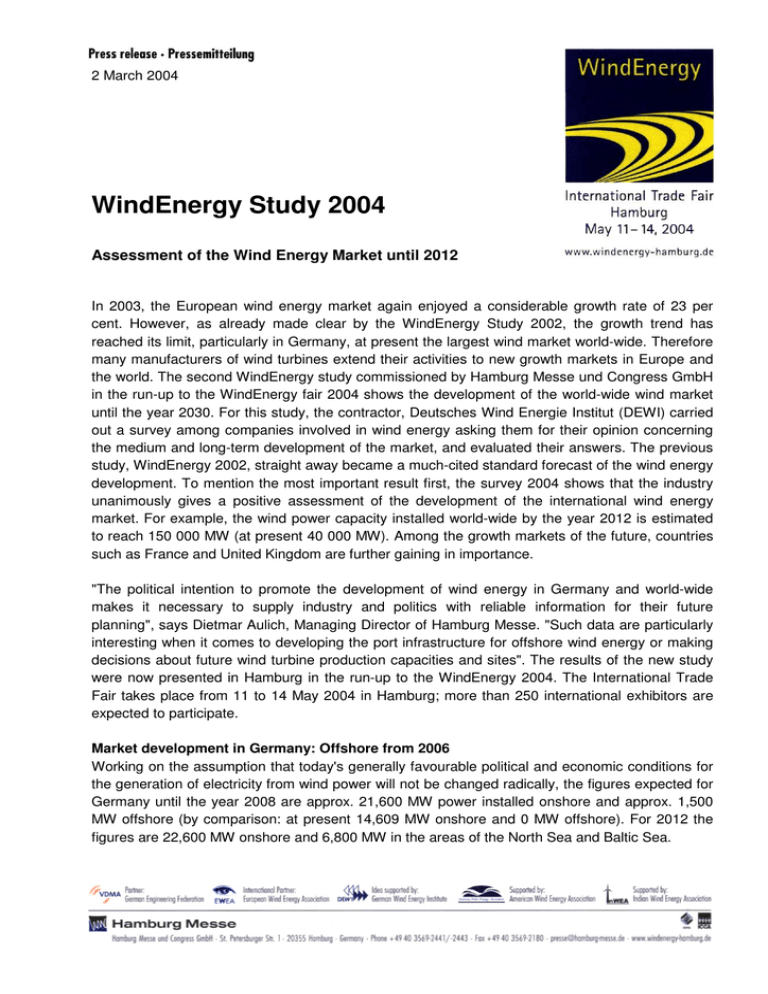
2 March 2004 WindEnergy Study 2004 Assessment of the Wind Energy Market until 2012 In 2003, the European wind energy market again enjoyed a considerable growth rate of 23 per cent. However, as already made clear by the WindEnergy Study 2002, the growth trend has reached its limit, particularly in Germany, at present the largest wind market world-wide. Therefore many manufacturers of wind turbines extend their activities to new growth markets in Europe and the world. The second WindEnergy study commissioned by Hamburg Messe und Congress GmbH in the run-up to the WindEnergy fair 2004 shows the development of the world-wide wind market until the year 2030. For this study, the contractor, Deutsches Wind Energie Institut (DEWI) carried out a survey among companies involved in wind energy asking them for their opinion concerning the medium and long-term development of the market, and evaluated their answers. The previous study, WindEnergy 2002, straight away became a much-cited standard forecast of the wind energy development. To mention the most important result first, the survey 2004 shows that the industry unanimously gives a positive assessment of the development of the international wind energy market. For example, the wind power capacity installed world-wide by the year 2012 is estimated to reach 150 000 MW (at present 40 000 MW). Among the growth markets of the future, countries such as France and United Kingdom are further gaining in importance. "The political intention to promote the development of wind energy in Germany and world-wide makes it necessary to supply industry and politics with reliable information for their future planning", says Dietmar Aulich, Managing Director of Hamburg Messe. "Such data are particularly interesting when it comes to developing the port infrastructure for offshore wind energy or making decisions about future wind turbine production capacities and sites". The results of the new study were now presented in Hamburg in the run-up to the WindEnergy 2004. The International Trade Fair takes place from 11 to 14 May 2004 in Hamburg; more than 250 international exhibitors are expected to participate. Market development in Germany: Offshore from 2006 Working on the assumption that today's generally favourable political and economic conditions for the generation of electricity from wind power will not be changed radically, the figures expected for Germany until the year 2008 are approx. 21,600 MW power installed onshore and approx. 1,500 MW offshore (by comparison: at present 14,609 MW onshore and 0 MW offshore). For 2012 the figures are 22,600 MW onshore and 6,800 MW in the areas of the North Sea and Baltic Sea. As against the forecast of 2002, the onshore development in the corresponding years is expected to be 8% to 9% higher, whereas in the offshore sector activities are expected to begin considerably later (2006/2007) than two years ago (2004). Although the initiation of offshore wind power will be delayed, a fast development is expected which could lead to an installed offshore capacity by the year 2012 almost 30 % higher (6,800 MW) than predicted in the previous study. This result shows the difficulties still existing in obtaining approvals, but also a more realistic assessment of the technical challenges. Once these initial problems have been overcome, an optimistic view is prevailing in the industry concerning a speedy realisation of the projects. This, however, is only possible if the infrastructure of the mainland grid can be developed and improved in time to be able to transmit the electricity generated offshore to the consumers onshore. In 2030, 30 % of German power consumption could be covered by wind energy The future wind energy market in Germany will consist of three segments, the development of new onshore areas, replacement of old wind turbines by more modern and larger turbines (repowering) and offshore wind energy use. Fig. 1 shows the development expected until the year 2030. By the end of the period shown, the installed capacity could reach approx. 23,700 MW onshore and 30,500 MW offshore, which is an increase of about 15% as against the forecast of 2002. This would mean that more than 30% of the German power consumption could be generated from wind power. The decline of the German wind energy market predicted two years ago, actually set in during 2003, but to a lesser extent than expected. The 2,645 MW of newly installed capacity are about 18% less than in the record year 2002, which with 3,246 MW surpassed all expectations, but Germany still remains by far the largest wind energy market of the world. A lack of suitable sites and the political intention to restrict wind energy use in inland areas are reflected in the further decline of the onshore market. Nevertheless, the situation is seen more positively than two years ago. The amendment of the Renewable Energies Act (EEG) will give an impetus to the offshore market Asked which will be the effects of the proposed amendment of the EEG (Renewable Energies Act) on the market, about 30% of the companies polled answered that they expected a strong impetus particularly for the offshore sector. On the other hand, 50 to 60% of the companies polled expect that the conditions on the onshore market will deteriorate as a result of the EEG revision (Fig. 2). The decline in yearly installations is expected to reach a low in 2006 with approx. 1,500 MW, which is a more optimistic estimate than two years ago: the companies then expected a decline in installation figures by 25% less. Due to the faster offshore development expected and an increase in repowering, the German market will experience a considerable growth from 2006 onwards. Taking the predicted onshore development as a basis, the 14,609 MW installed at the end of 2003, today already about two thirds of the installation are reached. International market development: new markets Even if the German market is not affected by decline as strongly as originally expected, nothing has changed concerning the fact that companies have to concentrate increasingly on the European and above all on the world market. As shown in Fig. 3, both markets together offer the chance to achieve further industrial growth in the next few years. Due to the dominant German market, however, a slight downward trend in yearly new installations is to be expected also on European level, and a further growth is only expected on a global level. In this connection, one should bear in mind, however, that this development depends to a large extent on the US market, which for example in 2002, due to the belated political decision to promote wind energy caused a significant change in the trend on the non-European market (Fig. 4). The German companies polled also indicated the five markets most important for them. Fig. 5 lists the countries mentioned in both surveys. Some countries, such as Poland and Turkey which were thought to be promising markets, did not meet expectations, but new markets, such as Austria and the United Kingdom, emerged, and France, for example, keeps gaining in importance. Spain and Italy will become less important in future, which, as far as Spain is concerned, has nothing to do with a decrease in new installations, but more likely depends on the prospects of German companies to realise projects in this country. The assessment of the Brazilian market has remained the same, which is not surprising since the long-awaited wind energy promotion programme will probably not start before March 2004. 150 000 MW forecast until the year 2012 The companies polled unanimously predict a positive development of the world market during the next five years, which is reflected in Fig. 3 by an increase in installed power from 7,700 MW in 2004 to approx. 11,000 MW in 2008 and finally by the year 2012 could reach a capacity of almost 18,000 MW. If this scenario can be realised as expected, the power installed in wind turbines world-wide will reach almost 150,000 MW in the year 2012 (at present 40,000 MW) (Fig. 6). It is interesting to note that up to and including 2003 the installed capacity per year in Germany is on average the same as the total capacity installed in the rest of Europe. Only after that date, Germany will be overtaken by the annual installation in the rest of Europe, due to its saturated onshore market, whereas the market outside Europe probably will become dominant only from 2011 on (Fig. 7). Opening up new markets: Joint Venture preferred In the survey, the companies were also asked to answer two questions concerning the best way to open up new markets and which were the main obstacles. 2/3 of the manufacturers and project developers consider a joint venture to be the most promising approach (Fig. 8), 16,7% of the manufacturers and 26,7% of the project developers would prefer to establish a subsidiary. Exporting from their home countries is preferred by 16.7% of the manufacturers and only 6.7% of the project developers. For all companies polled, the uncertainty regarding the energy politics in the target country is the main obstacle for an involvement, followed by the specific financing risks (Fig. 9). Whereas manufacturers consider an unstable political situation as an equally big obstacle, project developers seem more prepared to take risks. Lack of knowledge about the economic situation or political conditions is ranking only in the fourth position, and an insufficient infrastructure does not seem to have much influence on the decision to get involved in a certain country. Other applications : Wind-Diesel application coming Today, wind energy is used for generating electricity, onshore and offshore, which is fed into the public supply grid. In the medium and long term, however, there are other possibilities, too, such as using wind energy for water desalination, for saving fuel by integrating wind turbines in small diesel-electric grids, or for the production of hydrogen. In our survey, we therefore asked the companies when they would think that these applications could become interesting as additional market elements. The vast majority saw water desalination as a market not before 2007, only a minority thinks it could come earlier. Here there has been a shift in opinions compared with 2002, in favour of a beginning after 2007. Wind/diesel applications are considered to be interesting by most companies already after 2004 (in 2002, after 2007) and as far as wind/hydrogen is concerned, most companies seem to have no clear opinion (Fig. 10). UK takes the lead in offshore projects Asked in which country offshore projects could be realised with the greatest speed, the United Kingdom is mentioned most frequently, followed by Germany, Denmark, the Netherlands and Ireland (Fig. 11). Only in case of Denmark and Ireland there are considerable differences between the opinions of manufacturers and project developers. Summary: Excellent prospects, also in the long term To summarise the study it can be said that wind energy use not only in Germany, but above all world-wide has a great future ahead and that this environmentally friendly and resource-saving energy production will make an important contribution to a sustainable energy supply of humankind. The world market just starting to open up therefore offers excellent and long term possibilities for the companies. This positive prospect shows very clearly how important a joint, independent international fair will be for the wind energy sector. The WindEnergy International Trade Fair taking place for the second time is an ideal platform for wind turbine manufacturers and component suppliers, planners, finance institutes, surveying and certification organisations and experts from research and development to present their products and services to an international audience on an extended exhibition area. WindEnergy 2004 will be held from Tuesday 11 May to Friday 14 May. Opening times: 9am to 6pm, with longer opening up to 8pm on Thursday. Official international partners of WindEnergy are EWEA, AWEA and InWEA, and on a national level, VDMA and DEWI. Further information is available at www.windenergy-hamburg.de. Note: Charts are available in the press section of the website www.windenergy-hamburg.de The WindEnergy Study 2004 can be ordered by e-mail to: presse@hamburg-messe.de. Editor: Gudrun Blickle, Tel.: +49 40 35 69-2442, Fax: +49 40 35 69-2180, e-mail: gudrun.blickle@hamburg-messe.de
